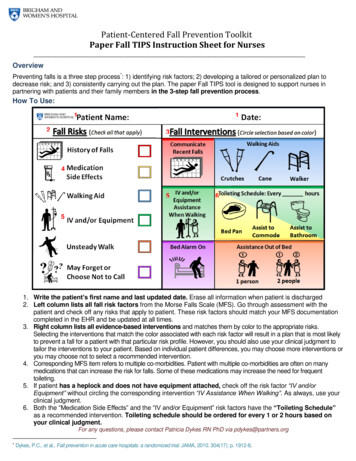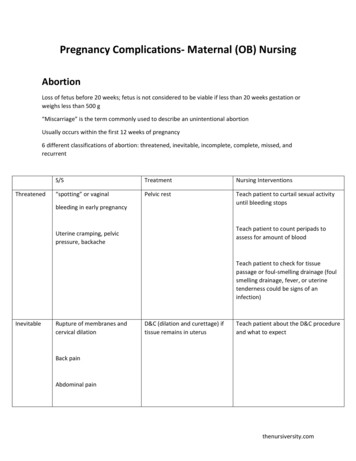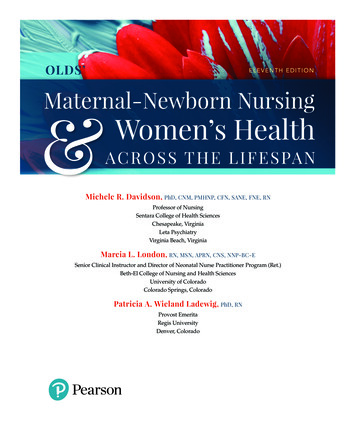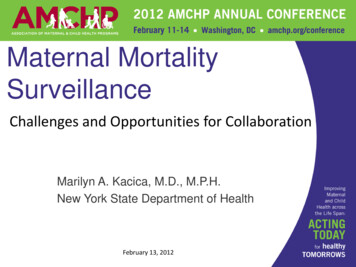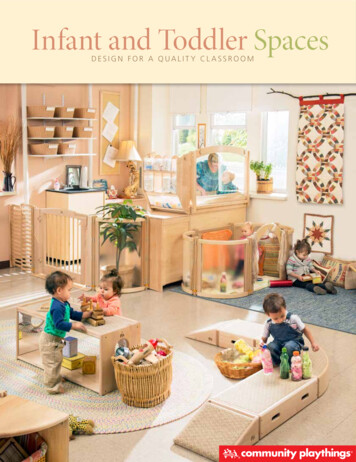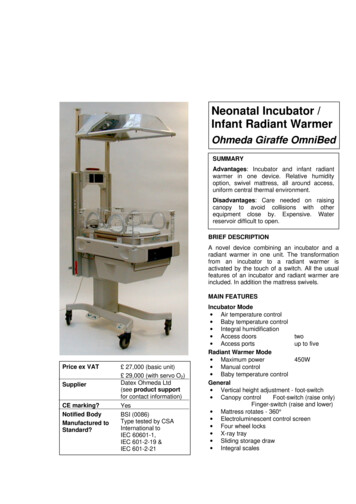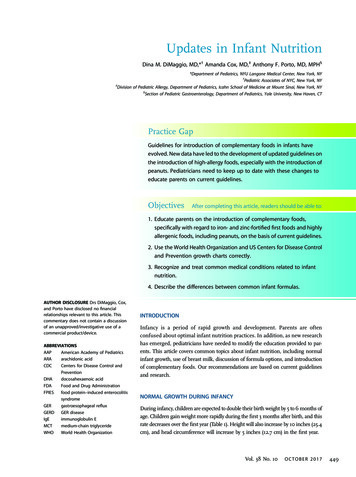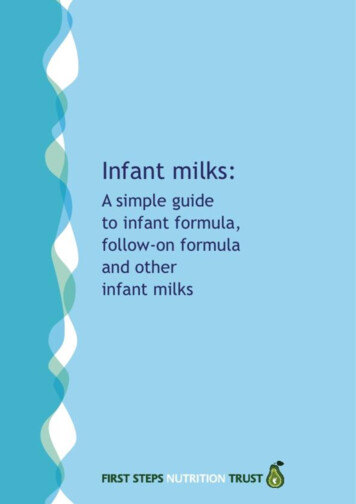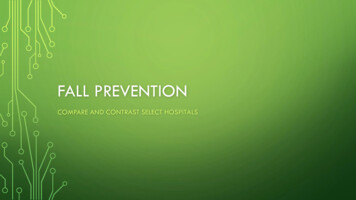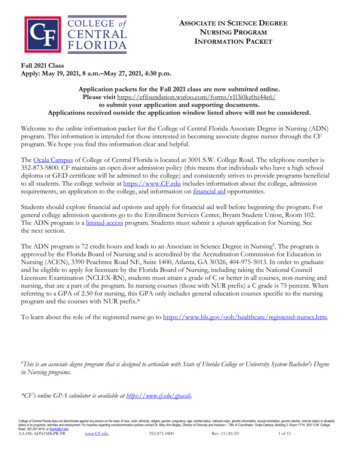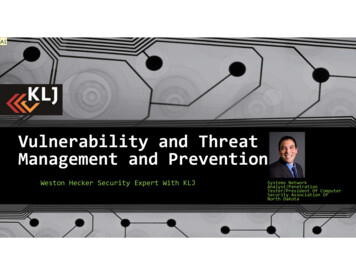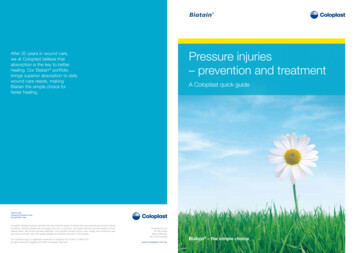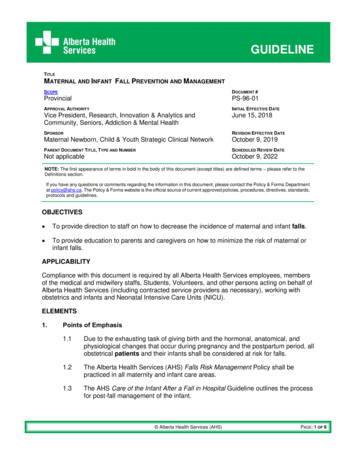
Transcription
GUIDELINETITLEMATERNAL AND INFANT FALL PREVENTION AND MANAGEMENTSCOPEDOCUMENT #ProvincialPS-96-01APPROVAL AUTHORITYINITIAL EFFECTIVE DATEVice President, Research, Innovation & Analytics andCommunity, Seniors, Addiction & Mental HealthJune 15, 2018SPONSORREVISION EFFECTIVE DATEMaternal Newborn, Child & Youth Strategic Clinical NetworkOctober 9, 2019PARENT DOCUMENT TITLE, TYPE AND NUMBERSCHEDULED REVIEW DATENot applicableOctober 9, 2022NOTE: The first appearance of terms in bold in the body of this document (except titles) are defined terms – please refer to theDefinitions section.If you have any questions or comments regarding the information in this document, please contact the Policy & Forms Departmentat policy@ahs.ca. The Policy & Forms website is the official source of current approved policies, procedures, directives, standards,protocols and guidelines.OBJECTIVES To provide direction to staff on how to decrease the incidence of maternal and infant falls. To provide education to parents and caregivers on how to minimize the risk of maternal orinfant falls.APPLICABILITYCompliance with this document is required by all Alberta Health Services employees, membersof the medical and midwifery staffs, Students, Volunteers, and other persons acting on behalf ofAlberta Health Services (including contracted service providers as necessary), working withobstetrics and infants and Neonatal Intensive Care Units (NICU).ELEMENTS1.Points of Emphasis1.1Due to the exhausting task of giving birth and the hormonal, anatomical, andphysiological changes that occur during pregnancy and the postpartum period, allobstetrical patients and their infants shall be considered at risk for falls.1.2The Alberta Health Services (AHS) Falls Risk Management Policy shall bepracticed in all maternity and infant care areas.1.3The AHS Care of the Infant After a Fall in Hospital Guideline outlines the processfor post-fall management of the infant. Alberta Health Services (AHS)PAGE: 1 OF 9
GUIDELINETITLEMATERNAL AND INFANT FALL PREVENTION AND MANAGEMENT1.4EFFECTIVE DATEOctober 9, 2019DOCUMENT #PS-96-01All mothers post-delivery and infants are considered at risk for falls but certainrisk factors that increase the chances of infant falls include:a)high level of fatigue of the mother or care provider;b)recent pain management or medications with sedative effects given to themother;c)night time;d)previous fall or near miss fall;e)maternal history of substance use; and/orf)pre-existing maternal conditions including epilepsy, diabetes, severeobesity, and depression, being treated with medications with sedativeeffects.Note: The most common occurrence of maternal falls is when the mother gets out ofbed to go to the bathroom for the first time post-delivery, followed by falls in the shower.The most common cause of infant falls is a caregiver falling asleep while holding theinfant.2.Fall Risk Factors2.12.2Care Providers:a)Persons caring for the infant should be assessed for their ability to safelyhandle and hold the infant. If the health care provider has concernsrelated to the caregiver’s physical or mental health, then they shouldattend and supervise the infant’s care.b)Health care providers holding or caring for the infant should perform aself-assessment of their mental alertness, stability, and mobility, and ifneeded, request that another health care provider assumes care for theinfant.Maternal Environment:a)The environment, including equipment and cords shall be organized toreduce the risk of entanglement and tripping.b)Pathways shall be clear of furniture, cords, and clutter.c)Slippery floors shall have appropriate signage.d)Lighting should be appropriate for ambulation.e)Equipment position should not hinder movement of the patient.f)Maternal bed rails should be raised and brakes engaged. Alberta Health Services (AHS)PAGE: 2 OF 9
GUIDELINETITLEMATERNAL AND INFANT FALL PREVENTION AND MANAGEMENT2.32.42.5EFFECTIVE DATEOctober 9, 2019DOCUMENT #PS-96-01Infant Environment:a)The infant’s environment shall support safe sleeping (See the AHS SafeInfant Sleep Policy).b)The infant may be placed in a bassinette with sides or a crib with elevatedrails.c)If the infant is placed on an overhead warmer, the panels shall be up andlocked.d)If the infant is placed in an incubator, the doors shall be closed andlocked.Transportation or Transfer of Infant:a)Infants shall be transported in their beds whenever possible.b)Two (2) health care providers shall be present when transporting a NICUinfant in an overhead warmer with the side rails low or down toaccommodate tubes or other infant care needs.c)The distance between the infant bed and the chair used for holding theinfant should be minimal.Communication and Patient Education:a)Health care providers shall support all patients and caregivers witheducation regarding prevention of infant falls on admission andthroughout their hospital stay.b)Obstetrical patients shall receive instructions by health care providers onhow to mitigate risk for maternal falls including:(i)providing opportunities for rest;(ii)encouraging visiting to take place at home after discharge;(iii)recognition of the effect of medications and an epidural on level ofalertness and balance;(iv)sitting on a side of the bed and dangling her legs until she feelscomfortable to stand;(v)utilizing bed side rails and hand rails when rising to a standingposition from bed or toilet;(vi)not showering until patient is hemodynamically stable to preventorthostatic hypotension;(vii)avoidance of overly hot showers; and Alberta Health Services (AHS)PAGE: 3 OF 9
GUIDELINETITLEMATERNAL AND INFANT FALL PREVENTION AND MANAGEMENT(viii)c)DOCUMENT #PS-96-01ensuring the floor is dry prior to stepping out of the shower.Health care providers shall provide mothers and caregivers witheducation on how to mitigate risk for infant falls including, but not limitedto:(i)always transferring the infant from one location to another in abassinette;(ii)using two (2) hands and holding the infant close to their bodywhen carrying;(iii)never leaving the infant on any unsecured or unstable surface,including the bed and raised flat surfaces;(iv)not tilting the head of the infant’s bed unless the infant is cared forwithin a closely monitored environment or in a NICU with the useof cardiac respiratory monitoring;(v)ensuring someone in the room is awake when the infant is in bedwith a care provider;(vi)chewing gum to assist with staying alert while holding, feeding,and practicing skin-to-skin care with the infant;(vii)returning the infant to the bassinette when the mother or careprovider is feeling drowsy;(viii)not sleeping while holding the infant in their arms unless in amonitored environment such as a NICU with a chair in a recliningposition and positioning belt in use; (ix)3.EFFECTIVE DATEOctober 9, 2019request assistance on the proper use of a reclining chair,positioning belt and/or other retaining support options tosupport the infant’s position on the mother’s chest whenpracticing skin-to-skin care; andcalling for help if assistance is needed to get the infant to theirbassinette.Process to Support Falls Prevention3.1If a mother is left alone feeding the infant, a health care provider should check onthe dyad every 30 minutes until the infant is returned to their bassinette.3.2Within the NICU, health care providers shall monitor the mother and infant duringskin-to-skin care, holding and feeding every 15 minutes. Alberta Health Services (AHS)PAGE: 4 OF 9
GUIDELINETITLEMATERNAL AND INFANT FALL PREVENTION AND MANAGEMENT3.34.5.EFFECTIVE DATEOctober 9, 2019DOCUMENT #PS-96-01Safety audits, rounds, and inspections shall incorporate falls preventionassessments based on obstetrical patient identification for universal fallsprecautions.Post-Fall Process4.1The health care provider shall call for assistance immediately when a patient fallsand proceed to secure the patient’s physical safety and prevent injury.4.2The health care provider shall not try to catch a patient who is falling; rather, theyshall ease them safely to a chair, bed, or onto the floor.4.3The most responsible health practitioner (MRHP) shall complete anddocument a medical assessment in the patient’s health record, post-fall.4.4Health care providers shall document all interventions and post-fall care. If apatient falls and is found unconscious or experiences head trauma, call a CodeBlue and request immediate medical assistance.4.5The Nurse or the MRHP shall notify the patient’s family and/or alternatedecision-maker, of the fall, health status, and planned management strategies.4.6For management of infant falls see Care of the Infant After a Fall in HospitalGuidelineDocumentation5.1Health care providers shall document in the health record, patient teachingregarding prevention of both maternal and infant falls.5.2Any concerns regarding increased fall risk to the infant, such as non-compliancewith health care provider recommendations, including discussions about the risksand potential consequences, shall be documented.5.3Health care providers are encouraged to report all maternal and infant falls aswell as near misses in the Reporting Learning System (RLS) for PatientSafety and report to the Charge Nurse and Unit Manager for follow-up (see theAHS Reporting of Clinical Adverse Events, Close Calls and Hazards Procedure).5.4Any maternal or infant fall shall be documented on the patient record including:location, time, and estimated distance of fall, what else was happening at thetime of the fall, assessment, and interventions that occurred.DEFINITIONSFall means an unplanned descent to the floor (or extension of the floor, e.g., trash can or otherequipment) with or without injury to the patient that occurs in an AHS setting. Alberta Health Services (AHS)PAGE: 5 OF 9
GUIDELINETITLEMATERNAL AND INFANT FALL PREVENTION AND MANAGEMENTEFFECTIVE DATEOctober 9, 2019DOCUMENT #PS-96-01Family(-ies) means one or more individuals identified by the patient as an important support,and who the patient wishes to be included in any encounters with the health care system,including, but not limited to, family members, legal guardians, friends and informal caregivers.Health care provider means any person who provides goods or services to a patient, inclusiveof health care professionals, staff, students, volunteers and other persons acting on behalf of orin conjunction with Alberta Health Services.Health record means the Alberta Health Services legal record of the patient's diagnostic,treatment and care information.Most responsible health practitioner (MRHP) means the health practitioner who hasresponsibility and accountability for the specific treatment/procedure(s) provided to a patient andwho is authorized by Alberta Health Services to perform the duties required to fulfill the deliveryof such a treatment/procedure(s) within the scope of his/her practice.Patient means an adult or child who receives or has requested health care or services fromAlberta Health Services and its health care providers or individuals authorized to act on behalfof Alberta Health Services. This term is inclusive of residents, clients and outpatients.Reporting Learning System (RLS) for Patient Safety means the electronic software programdesignated by Alberta Health Services to report patient related events resulting in adverseevents, close calls or hazards.REFERENCES Appendix A: Management of the Infant with Clinically Important Traumatic Brain Injury(ciTBI)Appendix B: Reference ListAlberta Health Services Governance Documents:o Care of the Infant After a Fall in Hospital Guideline (#PS-98-02)o Falls Risk Management Policy (#PS-58)o Reporting of Clinical Adverse Events, Close Calls and Hazards Procedure (#PS-11-01)o Safe Infant Sleep Policy and protocol (#PS-27)VERSION HISTORYDateOctober 09, 2019Click here to enter a dateAction TakenRevisedOptional: Choose an item Alberta Health Services (AHS)PAGE: 6 OF 9
GUIDELINETITLEMATERNAL AND INFANT FALL PREVENTION AND MANAGEMENTEFFECTIVE DATEOctober 9, 2019DOCUMENT #PS-96-01APPENDIX AManagement of the Infant with Clinically Important Traumatic Brain Injury (ciTBI)Asymptomatic or occult intracranial injury is significantly more prevalent in children greater than3 to 6 months of age. A linear skull fracture (SF) appears to be an independent risk factor forintracranial lesions, but skull radiographs need not be performed routinely in all cases ofnewborn falls. Younger age and scalp hematoma are predictors of SF. The incidence of SFfollowing a minor head injury (Glasgow Coma Scale 14 to 15) may be as high as 11% inchildren under 2 years of age. A skull radiograph should be performed in the presence of a largeboggy hematoma in a child younger than 2 years of age. If a SF is noted on a skull radiograph,consider neurosurgical consultation for advice on management and further imaging (CT or MRI)– especially if depressed, basilar, widened or depressed SF is less than 4 mm. In the context ofa SF, the incidence for late deterioration in children with a normal CT is negligible.Infants are at highest risk of clinically important Traumatic Brain Injury (ciTBI) from a fall. In thefollowing prediction model, the risk of ciTBI was 4.4% in children younger than 2 years of agewho had either altered mental status or palpable skull fractures. For those with none of the sixpredictors stated below, the risk of ciTBI was less than 0.02%.Six predictors of ciTBI in children less than 2 years of age are: Altered mental status Non-frontal scalp hematoma Loss of consciousness of 5 seconds or more Severe injury mechanism (includes fall from greater than 3 feet) Palpable skull fracture “Not acting normally” according to the parent (or irritability)If at least one of the above predictors is present, a CT scan of the head may be indicated.The decision to perform a CT scan shall take into consideration the following factors: Multiple vs isolated findings Focal neurologic find
assessments based on obstetrical patient identification for universal falls precautions. 4. Post-Fall Process 4.1 The health care provider shall call for assistance immediately when a patient falls and proceed to secure the patient’s physical safety and prevent injury. 4.2 The health care provider shall not try to catch a patient who is falling; rather, they shall ease them safely to a chair .
